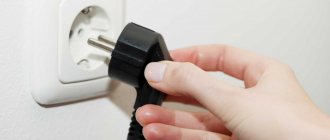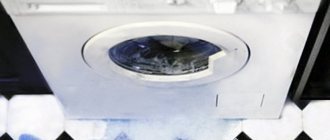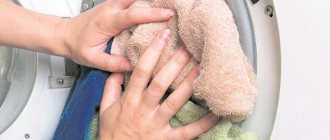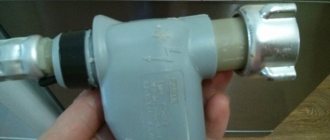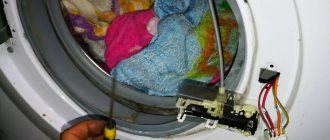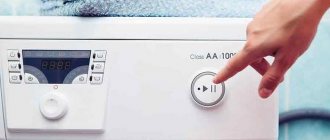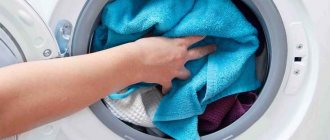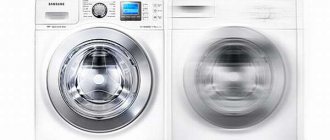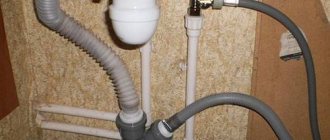Why is the washing machine leaking?
If the machine starts to leak, there are many reasons for this. Today, home appliance stores are filled with a large number of models of washing machines. Each of them is characterized by different malfunctions and weak points, which can lead over time to breakdown, leading to water leakage.
The first step is to determine which part of the machine the water is leaking from:
- Water appeared from below the washing machine, from under the legs. The reason may be the drain filter, perhaps it is simply not fully tightened.
- Water leaks out from under the machine when filling with water. You should inspect the fastenings to the body of the machine and the body of the inlet hose; perhaps the reason is that it is damaged and it has begun to leak water.
- Water leaks out of the dispenser when washing or rinsing. The reason is powder accumulated on the walls of the tray, which impedes the natural flow of water into the tank. The leak may be due to strong water flow. If the inlet valve allows a strong flow that washes powder out of the dispenser, then water may spill out.
- When the machine is turned off, you can hear the sound of water and you can see that there is a leak; the problem lies in the fill valve.
- Water flows from the hatch. There may be malfunctions of the hatch cuff.
- Water flows out from below during spinning. In this case, the drain pipes and hoses are most likely damaged.
Repair of household appliances
Attention. I, the founder of the “Master Himself” and this site, opened my own online store, as well as a retail store. The store itself is located in the city of Kharkov, 10 meters from the exit from the Studencheskaya metro station. You can find out how to get to this store on this page. For novice craftsmen and people who want to repair household appliances with their own hands, I provide a free consultation IF YOU PURCHASE A PRODUCT. Please understand that my time for consultations is limited, since there are many people who want to reduce the cost of repairs
The washing machine is leaking from below
Once a leak has been discovered, it is important to determine the location of the defect. There are many reasons for water leaking at the bottom of the machine. It doesn’t matter whether it’s an old model or a new one.
The main cause of the malfunction is considered to be hard water with impurities. This is often observed in low-cost models that use inexpensive materials and components.
There are other possible problems that can arise:
- non-compliance with the rules for operating the machine;
- use of poor quality chemicals;
- invisible manufacturing defect;
- accidental mechanical damage during operation.
When faced with a malfunction, the first thing to do is take the following actions:
- unplug the machine from the outlet without touching the puddle;
- turn off the water supply to the washing machine;
- get things out of the machine.
Next, you need to analyze possible leakage options. There are several of them:
- damage to hoses. It is worth carefully assessing its condition and, in case of damage, it is better to replace it with a new one;
- problems with pipes. You can encounter such a situation just a year after purchasing the machine, the reason lies in the manufacturer’s desire to save money;
- problems with the tank. If you wash belts with buckles, shoes and other similar items while using the machine, you should not be surprised that the tank leaks;
- problems with the seal. In this case, a leak occurs at the bottom of the machine during spinning;
- damage to the pump drain valve. Perhaps it is simply not screwed in completely. You can find out about this by removing the bottom panel of the machine.
Troubleshooting
To fix the problem, start inspecting all parts and components of the washing machine. Before doing this, unplug the machine and turn off the water.
Replace inlet hose
The hose is attached to the SMA body at the rear. Inspect the fastening: if it is loose, tighten the nut until it stops.
If you notice damage to the hose through which water is flowing, you should not repair it, it is better to completely replace it. For this:
- Unscrew one end of the hose from the housing.
- Disconnect the other end from the tap.
- Install the new element in reverse order.
You can buy a hose at a plumbing store. Pay attention to its length, it should not be too short.
Clean the dispenser and fill valve
Cleaning the tray is simple:
- Pull the tray towards you, pressing the latch in the center.
- Rinse it thoroughly under running water, removing any detergents.
To check the valve, you need to remove the top cover of the washing machine. Remove the two bolts from the back. You will see that there are two hoses leading from the valve to the hopper (depending on the type of valve). They are fastened with clamps.
Look: if any fastening has come off, it needs to be restored. If damaged, the hoses are replaced.
Repair the hatch cuff
The rubber seal on the hatch additionally seals all holes during washing. Over time, it can become leaky, which is facilitated by fungi and mold. The cuff is damaged during washing. These may be sharp objects that have not been removed from pockets.
What to do:
- Open the hatch door.
- Inspect the tires for signs of ruptures.
- If a small tear is noticed, you can seal it with a special moisture-resistant glue. Boat patches are also used. To perform a quality repair, it is better to remove the cuff from the hatch.
Information on how to remove the rubber seal may be useful when replacing it:
- Remove the outer clamp. After bending the cuff, pry the clamp with a flat screwdriver and remove it.
- Place the sealant inside the drum.
- Disconnect the hatch lock wiring and unscrew the bolts securing it.
- Remove the top cover from the case.
- Pull out the dispenser tray.
- Unscrew the control panel mounting bolts and disconnect it from the housing.
- Remove the plinth panel. Now remove all the bolts holding the front panel.
- With the panel out of the way, disconnect the upper and lower hoses leading to the cuff.
- Remove the inner clamp and the entire cuff from the tank.
If upon inspection it turns out that the damage to the rubber is too great, it is better to install a new element to prevent the accident from happening again.
Replace the filler pipe
To check the pipe from the hopper to the tank, you also need to remove the front panel. If, upon inspection, water leaks are found on the tank, then the problem is in the pipe. Since it is attached to the tank with glue, disconnect the pipe and dry it.
To secure the hose, clean the connection area. The element is attached using epoxy resin or glue.
Check tank
Today, washing machines are equipped with lightweight plastic tanks made of polymers. Therefore, small change or other items forgotten in your pockets can damage it. It happens that the heating element, overheating, ruptures, as a result of which its fragment damages the wall of the tank.
Before making a decision, you need to verify the malfunction:
- Inspect the SMA tank through the bottom for water leaks. If any are found, the tank needs to be replaced.
- If your CM is top-loading, remove the side panel for inspection.
Temporary tank repairs do not bring results. It will leak over time anyway.
Another cause of leakage may be damaged sealing rubber, which is located at the junction of the two parts of the tank. In any case, you will have to completely disassemble the washing machine, replace or repair the tank.
Replace the oil seal
When examining it, pay attention to the back. If drips are visible from the bearings, it means that the oil seal is worn out, or the lubricant has washed out and needs to be renewed.
The seal protects the bearings from moisture penetration. Therefore, when it wears out, the bearings also need to be replaced. To do this, buy a repair kit and special lubricant for oil seals in the store.
Washing machine leaks during spin cycle
If over the course of several washes it is discovered that water is flowing and this happens during the spin cycle, then there may be several reasons for this:
- the drain filter is clogged;
- the drain hose is damaged;
- seals not corrected;
- the drain pump is broken;
- bearings have failed;
- the tightness of the connection of the pipes is broken.
To figure out where the fault occurred, you must first turn off the power to the washing machine. Next, you need to check the condition of the water drain filter and whether it is clogged. Perhaps it is simply not completely closed, which is why water is leaking. You can find the filter at the bottom of the machine body, under the front bar.
Next, you should inspect the drain hose and the place where it is connected to the drain pump. For most well-known manufacturers, this place can be found through the bottom of the washing machine. It is enough to turn the machine on its side and make sure how tightly the hose is screwed to the pump.
If everything is normal here, it is necessary to inspect the seals and bearings. If the seals are worn, you can see water leaks in the rear of the drum. To verify this, you need to remove the back cover of the case. If the reason is in the bearings, then a grinding noise is heard when the drum rotates.
If the above reasons for water leakage are excluded, the last option remains - the drain pump is broken.
Broken door hinges or lock
Sometimes water flows from the hatch during washing due to improper operation of the washing machine or defects made during assembly.
If this is where the problem lies, it is quite simple to fix it by replacing the failed loops with new analogues. The most savvy washing machine owners can try to figure out where exactly the deformation occurred and try to level the surface without purchasing new hinges to replace it. By the way, to replace the fasteners on the hatch door you will need an open-end wrench, Phillips and slotted screwdrivers.
The washing machine can leak due to the failure of the door locking device. The reasons why the fastenings of the locking device fail are purely individual and depend on the brand of the washing machine and its model. It doesn’t matter at all what you use – Bosch, Ariston, Samsung, LG or another brand, in some the springs burst, in others the gaskets tear, which increases the backlash.
In this case, it is best to have a professional troubleshoot and fix it, because you will only waste time trying to figure out the cause of the water leak. But if you have a desire to work independently, we recommend the following algorithm of actions:
- Using a Phillips screwdriver, remove the panel of plastic material located around the glass of the loading door from its inside;
- loosen the door fastening of the hatch, disconnect it from the body part;
- we check the locking device of the hatch, we specify how movable the tongue of the mechanism is;
- Having discovered wear on any of the elements, we try to eliminate it.
Washing machine leaks when filling with water
If water begins to leak immediately during the dialing stage, you need to check the inlet hose. It probably simply “moved away” at the attachment points. It happens that the inlet hose is damaged and a leak appears for this very reason. In this situation, you will need to replace the hose with a new one.
When water flows out from under the machine during filling, the pipe is most likely damaged or its fastening has become loose in the section from the inlet valve to the dispenser, or from the dispenser to the tank. To accurately determine the location of the damage, you should remove the upper part of the device and replace the damaged part. If it is minor, it is not necessary to change the element; the hole can be sealed using a good quality sealant.
After the pipe is removed, it is processed and installed back using a special rubber-based glue. It's best to make sure everything is done correctly after the glue has completely dried.
The dispenser is to blame
It happens that the machine starts to leak as soon as water is supplied. Check the condition of the dispenser to see if it is clogged.
This happens when the powder is not completely dissolved and its remains clog the grate. The dispenser could also be clogged by sediment from dirty water. This also happens when there is excessive water pressure. You need to pull out the hopper with the dispenser and clean it. To reduce the water pressure, you can tighten the supply tap a little.
The washing machine is leaking from the door
The main cause of machine leakage is the door seal. Wear and tear leads to holes or abrasions, which causes water to leak inside the machine, which can then seep out from underneath the machine itself or leak from the door. It is worth noting that ruptures may not always be in the lower part; they also appear in the upper part and cause water leakage during spinning or rinsing.
If water is found on the front of the machine, the rubber seal should be inspected, but before doing so, it is necessary to ensure that there is no possibility of water leaking from the powder tray. A slight leak of water from the dispenser can flow down to the door in a thin path and create the appearance of water leaking from the door.
Wear of the rubber seal is a common cause of water leaking from the door. When the door is closed, the glass presses on the seal, forming a tight seal. Wear may be caused by chips and cuts. Perhaps it has simply worn out, that is, it has become hard and wavy, in which case it will need to be replaced.
Sometimes a leak can occur when an object gets between the glass and the seal, disturbing the seal. It is important to clean the door seal and glass from the inside where they come into contact while the machine is running. Such objects can be hairs, undissolved detergent, pieces of clothing, and scale.
Calling a specialist: the price of the issue
If you were unable to fix the leak on your own, it is recommended to contact a company that repairs washing household appliances, including Samsung.
Depending on the complexity of the repair, the cost of the work differs. In the capital and large cities, prices may be higher.
On average in Moscow:
- repair/replacement of pipes – from 900 rubles;
- replacing the hatch cuff - about 1,000 rubles, etc.
In most cases, device repairs are carried out by a technician on site. But in some cases, for a complete diagnosis, you may need to pick up the car to examine it in a workshop.
The price of parts that require replacement is not included in the price.
If the machine that is leaking is still under warranty, you should contact a service center for help . You should not try to repair the car yourself, as there are seals on it.
The buyer of a washing machine receives information about the location of the nearest service point and telephone numbers directly during the transaction.
If the car is no longer under warranty, then you should seek help from certified companies that have proven themselves in the service provision market. After completing the repair, the repairman issues a guarantee.
It is not advisable to call a master privately, based on a random advertisement, since there is a risk of falling for scammers who will lure you out of money, but either do not complete the work or do it poorly.
You will find all the most important and useful information about repairing Samsung washing machines in this section of the site.
Washing machine leaks while draining
There are three reasons for water leakage when draining:
- If water is detected at the front of the panel, the drain filter is most likely not screwed in completely. It’s easy to fix the malfunction; you just need to carefully tighten it without stripping the thread;
- If water is leaking from the bottom of the machine, then most likely the drain pipe is leaking. The part can be found at the bottom of the machine, it goes from the tank to the drain pump. You can assess the condition of the pipe by lifting the car;
- The most favorable option when water appears on the floor is considered to be damage to the drain hose. This part wears out most often during use of the machine. You can solve the problem of damaged drain hose yourself at home. A careful inspection of the hose along its entire length and at the point of its attachment to the body is necessary. If the hose is “loose”, it should be tightened better; if the reason is in the hose itself, then it is better to replace it.
Precautionary measures
If you walk into a room and see water on the floor near the washing machine, do not step into the puddle. Try to reach and pull out the plug from the socket, disconnect the SMA from the network. If this is not possible, turn off the power supply at the panel.
To stop the flow of water, turn off the water supply at the washer inlet valve. You can also turn off the water at the main tap in your apartment (house). Then proceed like this:
- Open the small hatch at the bottom of the front panel.
- Place the container and unscrew the filter, draining the remaining water from the tank.
- Take out and unscrew all the laundry.
Start inspecting the equipment.
